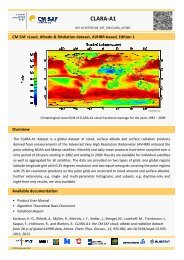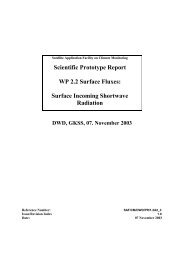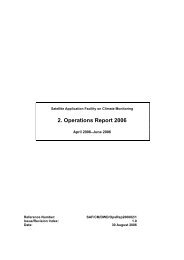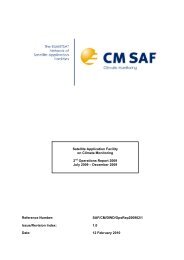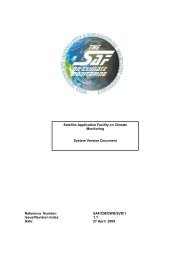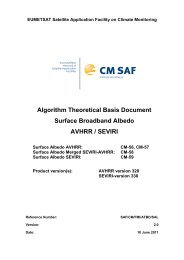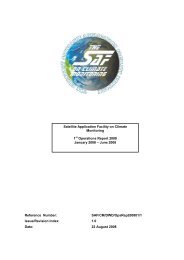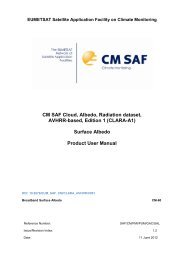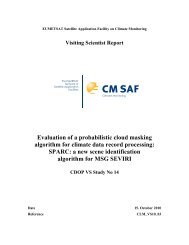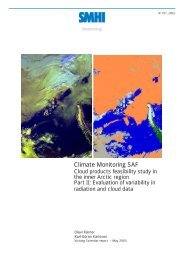Aerosol retrievals from METEOSAT-8 - CM SAF
Aerosol retrievals from METEOSAT-8 - CM SAF
Aerosol retrievals from METEOSAT-8 - CM SAF
Create successful ePaper yourself
Turn your PDF publications into a flip-book with our unique Google optimized e-Paper software.
<strong>SAF</strong> on Climate Monitoring Visiting Scientists Report Doc. No: 1.0<br />
Issue : 1.0<br />
Date : 4 October 2006<br />
surface using characteristics of SEVIRI. We will present the retrieval of the surface contribution<br />
and define the surface reflectance map of reference. Knowing the reflectance of the surface for each<br />
pixel and observation time, we will correct measurements for Rayleigh scattering. Using simple<br />
assumptions, aerosols optical thickness at a visible wavelength will be retrieved. The results will be<br />
compared with some AERONET data <strong>from</strong> stations available in the area of interest. Finally, we will<br />
go back to the assumptions we made in the retrieval scheme to explain the weakness of the method.<br />
6.1.3 Reference Surface Reflectance Map<br />
The signal measured by the instruments is a mix of different contribution of the Earth-Atmosphere<br />
system: surface, molecules, aerosols, gases and clouds.<br />
Cloud Masking<br />
First of all, cloudy pixels have to be removed for aerosol retrieval. Because of the short time we had<br />
to develop our methodology we used a simple cloud mask. It is based on threshold tests on the<br />
reflectance at 670 nm, 865nm and 1.6µm and brightness temperature at 11µm (see Appendix C). To<br />
avoid pixels containing cloud border, we also remove neighbouring pixels. Finally, the cloud mask<br />
we used does not detect cloud shadows, which produce pixels with lower reflectances than the<br />
surface reflectance alone.<br />
Rayleigh correction<br />
Once the cloud masking is done, the contribution of the Rayleigh scattering at 670nm is removed<br />
<strong>from</strong> the signal using classical method adapted to the spectral properties of the channel. The<br />
remaining quantity (R ray_corrected ) is then the contribution of the surface and the aerosols.<br />
Surface contribution<br />
The surface reflectance map is built <strong>from</strong> the 3D data set of the Rayleigh corrected reflectances<br />
corresponding to the cloud-free cases. For each time slot (<strong>from</strong> 5:00 UTC till 19:00 UTC, every 15<br />
minutes) we have, at maximum, a set of 14 values of the Rayleigh corrected pixel reflectances. The<br />
three dimensions of the data set are the pixel longitude, latitude and the date (1 to 14 July). The<br />
retrieval method assumes that the minimum value corresponds to the zero aerosol case, or at least,<br />
the case with the least aerosol contamination. In another words, the minimum is the value of the<br />
surface reflectance (R surf_ref ) seen in the correct geometry. The value obtained is assumed to<br />
correspond with the reflectance for a lambertian surface as simulated in radiative transfer<br />
- 18 -



